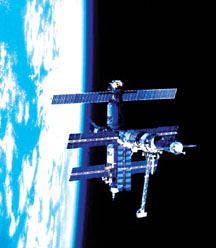
Satellites around the Earth
Not so long ago, satellites were exotic, top-secret devices. They
were mainly used for military purposes, for activities such as
navigation (directing the course of a vehicle) and espionage (spying).
Now, satellites are an essential part of our daily lives. We see and
recognise their use in weather reports, television transmission and
everyday telephone calls.
In many other instances, satellites play a background role that
escapes our notice: some newspapers and magazines are more timely
because they transmit their text and images to multiple printing sites
via satellite to speed local distribution. Emergency radio beacons from
downed aircraft and distressed ships may reach search-and-rescue teams
when satellites relay the signal.
What is a satellite?
A satellite is basically any object that revolves around a planet in
a circular or elliptical path. The moon is Earth's original, natural
satellite, and there are many man-made (artificial) satellites, usually
closer to Earth.

* The path a satellite follows is an orbit. In the orbit, the
farthest point from Earth is the apogee, and the nearest point is the
perigee.
* Artificial satellites generally are not mass-produced. Most
satellites are custom-built to perform their intended functions.
Exceptions include the GPS satellites (with over 20 copies in orbit) and
the Iridium satellites (with over 60 copies in orbit).
* Approximately 23,000 items of space junk - objects large enough to
track with radar that were inadvertently (unintentional) placed in orbit
or have outlived their usefulness - are floating above the Earth. The
actual number varies depending on which agency is counting. Payloads
(the total load of the craft) that go into the wrong orbit, satellites
with run-down batteries, and leftover rocket boosters all contribute to
this count.
Although anything that is in orbit around the Earth is technically a
satellite, the term "satellite" is typically used to describe a useful
object placed in orbit purposely to perform some specific mission or
task. We commonly hear about weather satellites, communication
satellites and scientific satellites.
The Soviet Sputnik satellite launched on October 4, 1957, was the
first to orbit the Earth. Sputnik was a 23-inch (58-cm), 184-pound
(83-kg) metal ball. On the outside of Sputnik, four whip antennae
transmitted on short-wave frequencies above and below what is today's
Citizens Band (27 MHz).

However, after 92 days, gravity took over and Sputnik burned in the
Earth's atmosphere. Thirty days after the Sputnik launch, the dog Laika
orbited in a half-ton Sputnik satellite, with an air supply for the dog.
It burned in the atmosphere in April 1958.
Sputnik is a good example of just how simple a satellite can be.
Today's satellites are generally far more complicated, but the basic
idea is a straightforward one.
How a satellite is launched into orbit
All satellites today get into the orbit by riding on a rocket or by
riding in the cargo bay of the space shuttle. Several countries and
businesses have rocket launch capabilities, and satellites as large as
several tons make it safely into the orbit on a regular basis.
For most satellite launches, the scheduled launch rocket is aimed
straight up at first. This gets the rocket through the thickest part of
the atmosphere most quickly, and best minimises fuel consumption. After
a rocket launches straight up, the rocket control mechanism uses the
inertial (motionless) guidance system to calculate the necessary
adjustments to the rocket's nozzles, to tilt the rocket to the course
described in the flight plan.
In most cases, the flight plan calls for the rocket to head east
because the Earth rotates to the east, giving the launch vehicle a free
boost. The strength of this boost depends on the rotational velocity
speed of the Earth at the launch location. The boost is greatest at the
equator, where the distance around the Earth is greatest and so rotation
is fastest.
Once the rocket reaches extremely thin air, at about 120 miles (193
km) up, the rocket's navigational system fires small rockets, just
enough to turn the launch vehicle into a horizontal position. The
satellite is then released. At that point, rockets are fired again to
ensure some separation between the launch vehicle and the satellite
itself.
Read more on satellites later.
Types of satellite orbits
There are three basic kinds of orbits, depending on the satellite's
position relative to the Earth's surface:
* Geostationary orbits (also called geosynchronous or synchronous)
are orbits in which the satellite is always positioned over the same
spot on Earth. Many geostationary satellites are above a band along the
equator, with an altitude of about 22,223 miles, or about a tenth of the
distance to the Moon. The "satellite parking strip" area over the
equator is becoming congested with several hundred television, weather
and communication satellites! This congestion means each satellite must
be precisely positioned to prevent its signals from interfering with an
adjacent satellite's signals. Television, communications and weather
satellites all use geostationary orbits. Geostationary orbits are why a
DSS satellite TV dish is typically bolted in a fixed position.
* The scheduled space shuttles use a much lower, synchronous orbit,
which means they pass overhead at different times of the day. Other
satellites in synchronous orbits average about 400 miles (644 km) in
altitude. * In a polar orbit, the satellite generally flies at a low
altitude and passes over the planet's poles on each revolution. The
polar orbit remains fixed in space as the Earth rotates inside the
orbit. As a result, much of the Earth passes under a satellite in a
polar orbit. Because polar orbits achieve excellent coverage of the
planet, they are often used for satellites that do mapping and
photography. |


